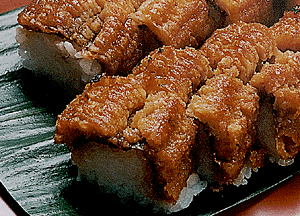| Hamo has a very delicate, pleasant taste. The flesh of fresh hamo is beautifully and immaculately white, and can be cooked in a variety of ways. The root meaning of the Chinese character for hamo is "rich fish", probably because it is so versatile. However, the problem with cooking hamo is the process of honekiri (bone cutting). This is all but impossible for amateurs. Hamo contain many fine bones, some of which are very close to the skin, making them impossible to remove completely. The fine bones therefore have to be cut into tiny pieces. Master chefs are said to make up to 25 cuts in a width of only 3 cm. Of course this is an exaggeration, but the more cuts there are, the better the taste. Try asking your fishmonger to do it for you. Hamo-chiri, pieces of hamo placed briefly in boiling water and served with mustard-miso sauce or mashed pickled ume plums, kudzu-tataki and teriyaki are among the most common ways to cook hamo. Kudzu-tataki is used in soups and simmered and steamed dishes. Teriyaki hamo is used for sushi or served with cucumbers. Hamo tempura is delicious also. Hamo can even be cooked in a pot with eggs and burdock root in the Yanagawa style. The best combination of ingredients for dobin-mushi, an autumn seasonal delicacy, is matsutake mushrooms and hamo. What a fabulous flavour! You will be amazed by the astonishing variety of flavours in Japanese cuisine. Hamo is also ground into paste to make kamaboko and hampen. The skin is broiled with sauce and used in other dishes, and is even available in stores. Remove the fine bones and fins, chop finely and season with sweet vinegar. It makes a nice small dish. In fact, no part of a hamo needs to be thrown away. | 